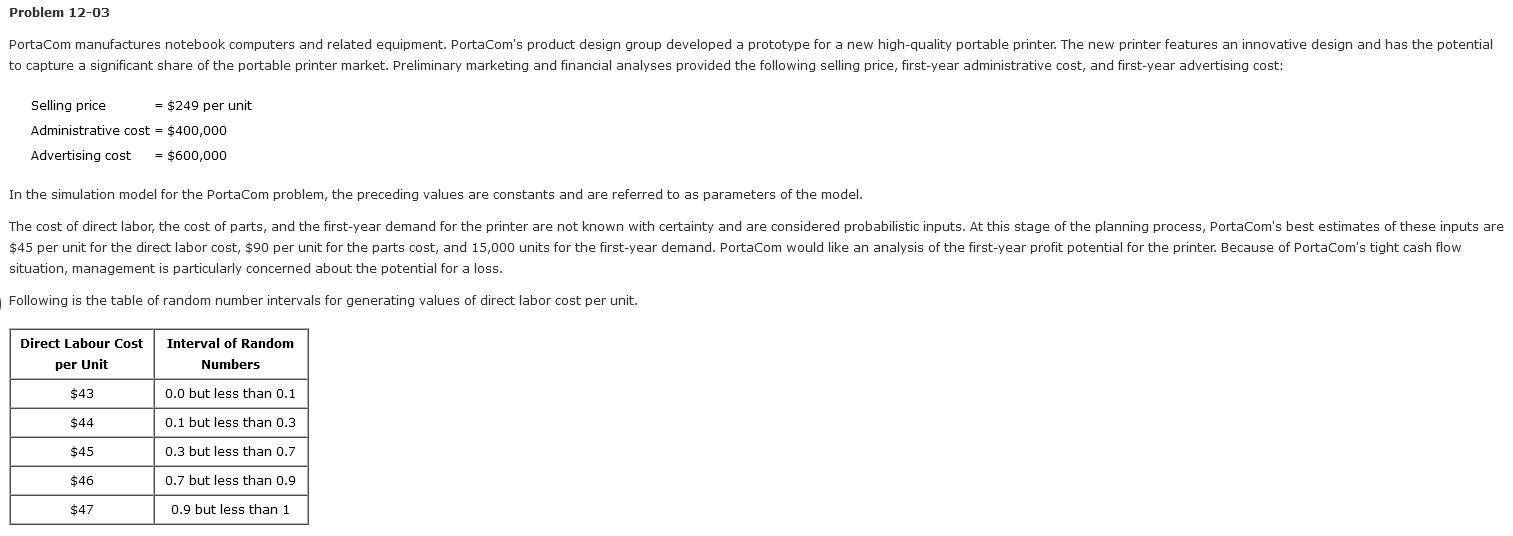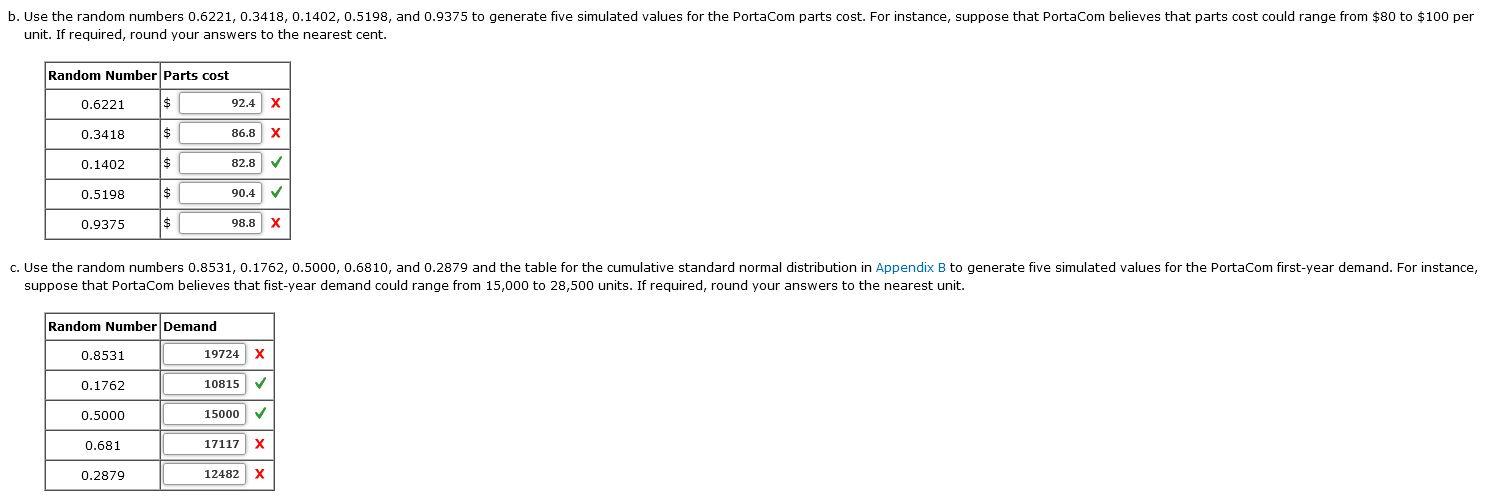Zoom in to read


Problem 12-03 PortaCom manufactures notebook computers and related equipment. PortaCom's product design group developed a prototype for a new high-quality portable printer. The new printer features an innovative design and has the potential to capture a significant share of the portable printer market. Preliminary marketing and financial analyses provided the following selling price, first-year administrative cost, and first-year advertising cost: Selling price = $249 per unit Administrative cost = $400,000 Advertising cost = $600,000 In the simulation model for the Portacom problem, the preceding values are constants and are referred to as parameters of the model. The cost of direct labor, the cost of parts, and the first-year demand for the printer are not known with certainty and are considered probabilistic inputs. At this stage of the planning process, PortaCom's best estimates of these inputs are $45 per unit for the direct labor cost, $90 per unit for the parts cost, and 15,000 units for the first-year demand. PortaCom would like an analysis of the first-year profit potential for the printer. Because of PortaCom's tight cash flow situation, management is particularly concerned about the potential for a loss. Following is the table of random number intervals for generating values of direct labor cost per unit. Direct Labour Cost Interval of Random Numbers per Unit $43 0.0 but less than 0.1 $44 0.1 but less than 0.3 0.3 but less than 0.7 $45 $46 0.7 but less than 0.9 $47 0.9 but less than 1 b. Use the random numbers 0.6221, 0.3418, 0.1402, 0.5198, and 0.9375 to generate five simulated values for the PortaCom parts cost. For instance, suppose that PortaCom believes that parts cost could range from $80 to $100 per unit. If required, round your answers to the nearest cent. Random Number Parts cost 0.6221 $ 92.4 x 0.3418 $ 86.8 0.1402 $ 82.8 0.5198 $ 90.4 0.9375 $ 98.8 X c. Use the random numbers 0.8531, 0.1762, 0.5000, 0.6810, and 0.2879 and the table for the cumulative standard normal distribution in Appendix B to generate five simulated values for the PortaCom first-year demand. For instance, suppose that PortaCom believes that fist-year demand could range from 15,000 to 28,500 units. If required, round your answers to the nearest unit. Random Number Demand 0.8531 19724 X 0.1762 10815 0.5000 15000 0.681 17117 X 0.2879 12482 x Problem 12-03 PortaCom manufactures notebook computers and related equipment. PortaCom's product design group developed a prototype for a new high-quality portable printer. The new printer features an innovative design and has the potential to capture a significant share of the portable printer market. Preliminary marketing and financial analyses provided the following selling price, first-year administrative cost, and first-year advertising cost: Selling price = $249 per unit Administrative cost = $400,000 Advertising cost = $600,000 In the simulation model for the Portacom problem, the preceding values are constants and are referred to as parameters of the model. The cost of direct labor, the cost of parts, and the first-year demand for the printer are not known with certainty and are considered probabilistic inputs. At this stage of the planning process, PortaCom's best estimates of these inputs are $45 per unit for the direct labor cost, $90 per unit for the parts cost, and 15,000 units for the first-year demand. PortaCom would like an analysis of the first-year profit potential for the printer. Because of PortaCom's tight cash flow situation, management is particularly concerned about the potential for a loss. Following is the table of random number intervals for generating values of direct labor cost per unit. Direct Labour Cost Interval of Random Numbers per Unit $43 0.0 but less than 0.1 $44 0.1 but less than 0.3 0.3 but less than 0.7 $45 $46 0.7 but less than 0.9 $47 0.9 but less than 1 b. Use the random numbers 0.6221, 0.3418, 0.1402, 0.5198, and 0.9375 to generate five simulated values for the PortaCom parts cost. For instance, suppose that PortaCom believes that parts cost could range from $80 to $100 per unit. If required, round your answers to the nearest cent. Random Number Parts cost 0.6221 $ 92.4 x 0.3418 $ 86.8 0.1402 $ 82.8 0.5198 $ 90.4 0.9375 $ 98.8 X c. Use the random numbers 0.8531, 0.1762, 0.5000, 0.6810, and 0.2879 and the table for the cumulative standard normal distribution in Appendix B to generate five simulated values for the PortaCom first-year demand. For instance, suppose that PortaCom believes that fist-year demand could range from 15,000 to 28,500 units. If required, round your answers to the nearest unit. Random Number Demand 0.8531 19724 X 0.1762 10815 0.5000 15000 0.681 17117 X 0.2879 12482 x








